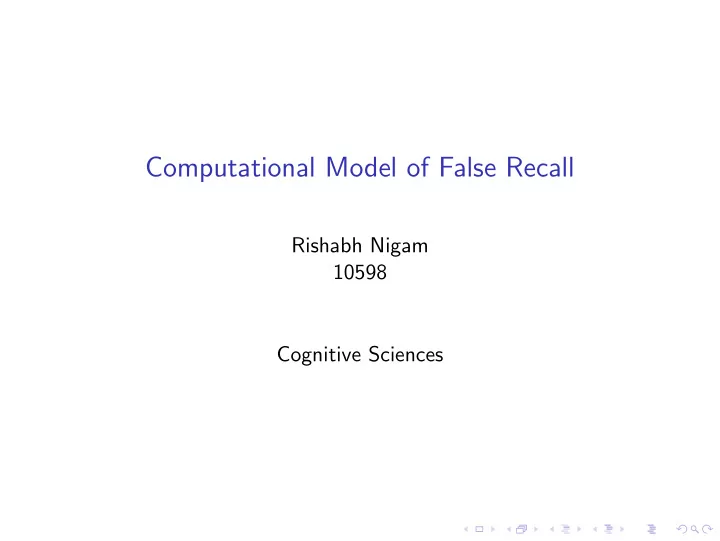

Computational Model of False Recall Rishabh Nigam 10598 Cognitive Sciences
Introduction ◮ False Recall - > remembering events that didn’t happened. ◮ Deese demonstrated this using a word list in 1959. ◮ Experiment: The participants were read 6 lists of 12 words each and then they were asked to recall the members of this list ◮ The list were constructed based on a critical word. The associates of the critical word were presented in the list. ◮ Results The people when asked to recall the list, recalled the critical lure with a probability of 0.4 which was equal to the probability of recall of middle words.
Introduction ◮ McDermott and Roediger extended Deese experiment in 1995. ◮ They conducted 2 experiments. ◮ Experiment 1: They duplicated Deese work, but they tested the participants on recognition of the words also. src: 2
Roediger and McDermott ◮ Experiment 2 - major features ◮ Remember vs Know ◮ Impact of Bigger list ◮ Effect of recall on subsequent recognition. ◮ False recall rates of critical words when the relevant lists were not presented.
Results ◮ Experiment 2 - major features ◮ Remember vs Know src: 2
Results ◮ Impact of Bigger list – Bigger list were found to have a greater false recall (0.55 compared to 0.4) ◮ Effect of recall on subsequent recognition. – Participants recognized the studied word as well as critical lure more. ◮ False recall rates of critical words when the relevant lists were not presented. – This was similar to normal words.
Observations ◮ Recognition of lures semantically related to other words. ◮ Implicit associative response. eg. On seeing a word such as hot, might think of associate cold. ◮ Activation may spread using an associative network. ◮ Both during encoding and retrieval the associations get triggered.
fSAM model ◮ Search for Associative Memory. ◮ It says that list items become associated with each other and with the context. ◮ This association is proportional to the time spent in limited capacity rehersal buffer. ◮ retrieval from Long Term memory is cue dependent. previously recalled items serve as a cue, and the word having the largest cue is more likely to be recalled. ◮ Word association space
fSAM model ◮ Different Versions based on whether to consider only the last recalled word, or all the word currently in the buffer. Then how to add the contribution of all the words in the buffer list. (Multiply/Sum) ◮ LTM - > association between list words and lists context, association between list words and other list words. ◮ STM fixed with size 4 for better results. ◮ Preexisting semantic matrix is used.
References 1 [Daniel R. Kimball, Troy A. Smith, Michael J. kahana] ”The fSAM Model of False Recall”,Psychological Review 2007 Pg 954-993 2 [Henry L Roediger, kathleen B. McDermott] ”Creating False Memories: Remembering Words not presented in Lists ”, Journal of Experimental Psychology, Learning Memory and Cognition, 1995 pg 803-814 3 [David R.Cann, Ken McRae, Albert N Katz] ”False recall in the Deese-Roediger-McDermott paradigm: The roles of gist and associative strength”, Q J Exp Psychol (Hove) 2011 pg 1515-42
Additional Information ◮ Fuzzy Trace Theory – verbatim trace and gist trace formed during encoding. Assesing the gist trace at retrieval promotes recall of critical word. ◮ Verdical recall vs false recall
Question/Answers Q. Difference between knowing and remembering ? Ans. McDermott says it as follows ”A remember experience is defined as one in which the subject can mentally relieve the experience(perhaps by recalling its neighbours, what it made them think of, what they were doing when they heard the word etc). A know judgement is made when subjects are confident that the item occured on the list but are unable to reexperince its occurrence.”
Recommend
More recommend